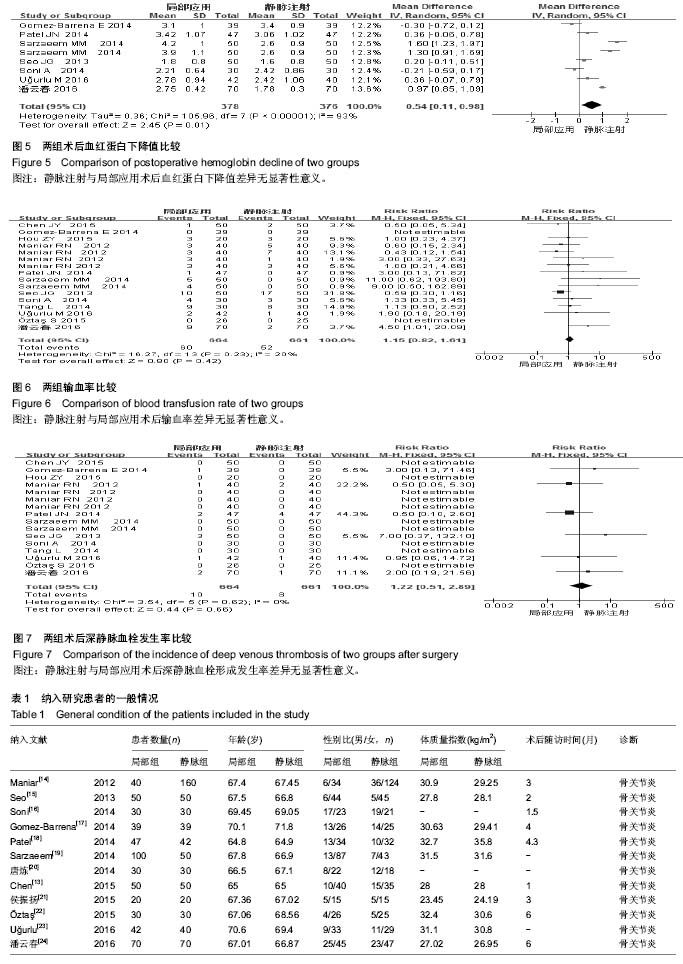| [1] Toy PT, Kaplan EB, McVay PA, et al. Blood loss and replacement in total hip arthroplasty: a multicenter study. The preoperative autologous blood donation study group. Transfusion. 1992;32(1):63-67.[2] Kalairajah Y, Simpson D, Cossey AJ, et al. Blood loss after total knee replacement: effects of computer-assisted surgery. J Bone Joint Surg (Br).2005;87:1480-1482.[3] Bagsby DT, Hur J. Effect of intra-articular injection of tranexamic acid on postoperative hemoglobin in total hip arthroplasty. Orthopedics.2014;37(6): 557-562.[4] Frisch NB, Wessell NM, Charters MA, et al. Predictors and complications of blood transfusion in total hip and knee arthroplasty. J Arthroplasty.2014,29:189-192.[5] Fiebig E. Safety of the blood supply. Clin Orthop Relat Res. 1998;357:6-18.[6] Sukeik M, Alshryda S, Haddad FS, et al. Systematic review and meta-analysis of the use of tranexamic acid in total hip replacement. J Bone Joint Surg Br. 2011;93:39-46.[7] Lemaire R. Strategies for blood management in orthopaedic and trauma surgery. J Bone Joint Surg Br.2008;90:1128-1136.[8] Kumar A. Perioperative management of anemia: limits of blood transfusion and alternatives to it. Cleve Clin J Med. 2009;76(Suppl 4):S112-118.[9] Shander A, Hofmann A, Ozawa S, et al. Activity-based costs of blood transfusions in surgical patients at four hospitals. Transfusion.2010,50:753-765.[10] Gilbody J, Dhotar HS, Perruccio AV, et al. Topical tranexamic acid reduces transfusion rates in total hip and knee arthroplasty. J Arthroplasty.2014;29: 681-684.[11] Samujh C, Falls TD, Wessel R, et al. Decreased blood transfusion following revision total knee arthroplasty using tranexamic acid. J Arthroplasty.2014;29:182-185.[12] Phan DL, Rinehart JB, Schwarzkopf R. Can tranexamic acid change preoperative anemia management during total joint arthroplasty? World J Orthop. 2015;6(7):521-527.[13] Chen JY, Chia SL, Lo NN, et al. Intra-articular versus intravenous tranexamic acid in primary total knee replacement. Ann Transl Med. 2015;3(3):33.[14] Maniar RN, Kumar G, Singhi T, et al. Most effective regimen of tranexamic acid in knee atthroplasty:a prospective randomized controlled study in 240 patients. Clin Orthop Relat Res. 2012;470(9):2605-2612.[15] Seo JG, Moon YW, Park SH, et al. The comparative efficacies of intra-articular and IV tranexamic acid for reducing blood loss during total knee arthroplasty. Knee Surg Sports Traumatol Arthrose. 2013;21(8):1869-1874.[16] Soni A, Saini R, Gulati A, et al. Comparison between intravenous and intra-articular regimens of tranexamic acid in reducing blood loss during total knee arthroplasty. J Arthroplasty. 2014;29(8):1525-1527.[17] Gomez-Barrena E, Ortega-Andreu M, Padilla-Eguiluz NG, et al. Topical intra-articular compared with intravenous tranexamic acid to reduce blood loss in primary total knee replacement:a doubleblind, randomized,controlled, noninferiority clinical trial. J Bone Joint Surg Am. 2014;96(23): 1937-1944.[18] Patel JN, Spanyer JM, Smith LS, et al. Comparison of intravenous versus topical tranexamic acid in total knee arthroplasty:a prospective randomized study. J Arthroplasty. 2014;29(8):1528-1531.[19] Sarzaeem MM, Razi M, Kazemian G, et al. Comparing efficacy of three methods of tranexamic acid administration in reducing hemoglobin drop fonowing total knee arthroplasty. J Arthroplasty. 2014;29(8):1521-1524.[20] 唐炼.氨甲环酸对膝关节置换术患者静脉与关节内失血的影响研究[J].中国生化药物杂志, 2014,34(7):105-107.[21] 侯振扬.初次单侧骨水泥型全膝关节置换:氨甲环酸使用方式对失血量的影响[J].中国组织工程研究, 2015,19(9):1329-1334.[22] Özta? S, Öztürk A, Akalin Y, et al. The effect of local and systemic application of tranexamic acid on the amount of blood loss and allogeneicblood transfusion after total knee replacement. Acta Orthop Belg. 2015;81(4):698-707.[23] U?urlu M, Aksekili MA, Ça?lar C, et al. Effect of topical and intravenously applied tranexamic acid compared to control group on bleeding in primary unilateral total knee arthroplasty. J Knee Surg. 2017;30(2):152-157.[24] 潘云春.静脉及局部应用氨甲环酸对全膝关节置换围术期失血的影响[J].中国医药导报,2016, 11(12):156-159.[25] Panteli M, Papakostidis C, Dahabreh Z, et al.Topical tranexamic acid in total knee replacement: a systematic review and meta-analysis. Knee. 2013;20( 5):300-309.[26] Andersson L, Nilsson IM, Nilehn JE, et al.Experimental and clinical studies on AMCA, the antifibrinolytically active isomer of paminomethyl cyclohexane carboxylic acid. Scand J Haematol. 1965;2:230-247.[27] Ahlberg A, Eriksson O, Kjellman H. Diffusion of tranexamic acid to the joint. Acta Orthop Scand. 1976;47:486-488.[28] Wong J, Abrishami A, EI Beheiry H, et al. Topical application of tranexamic acid reduces postoperative blood loss in total knee arthroplasty: a randomized, controlled trial. J Bone Joint Surg Am. 2010;92:2503-2513. |
.jpg)



.jpg)